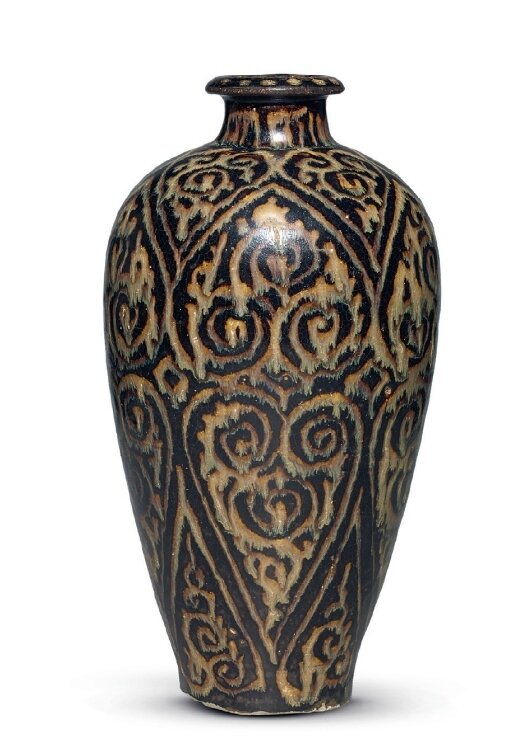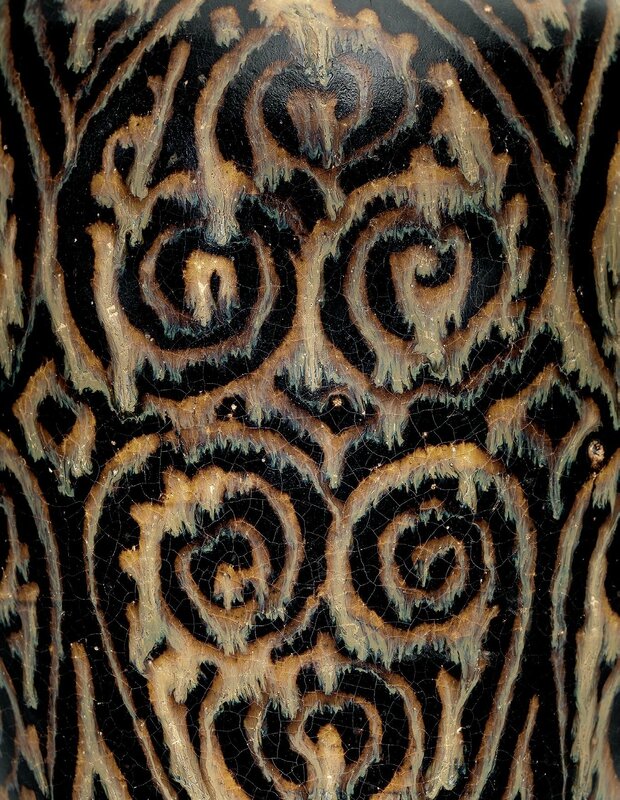A very rare Jizhou tixi-style painted meiping, Southern Song-Yuan dynasty, 13th-14th century
Lot 2825. A very rare Jizhou tixi-style painted meiping, Southern Song-Yuan dynasty, 13th-14th century;8 3/4 in. (22.2 cm.) high. Estimate HK$1,000,000 - HK$1,500,000 ($129,636 - $194,454). Price Realized HK$2,920,000 ($378,537). © Christie's Image Ltd 2015
The slender oviform body is painted with an overall pattern of ruyi-shaped panels enclosing connecting spirals in a creamy coffee brown glaze, simulating tixi lacquer. The narrow neck is further decorated with a key-fret band, below a rounded lip painted with a band of dots. The meiping is covered with a dark brownish glaze that continues inside that neck, Japanese wood box
Provenance: Sen Shu Tey, Tokyo
Literature: Sen Shu Tey, The Collection of Chinese Art, Tokyo, 2006, p. 64, no. 79
Christie's, The Classical Age of Chinese Ceramics: An Exhibition of Song Treasures from the Linyushanren Collection, Hong Kong, 2012, pp. 112-113, no. 43
Rosemary Scott, ‘Chinese Classic Wares from a Japanese Collection: Song Ceramics from the Linyushanren Collection’,Arts of Asia, March-April 2014, pp. 97-108, fig. 15
Exhibited: Sen Shu Tey, Special Exhibition ‘Run Through 10 Years’, Tokyo, 2006, Catalogue, no. 79
Christie's, The Classical Age of Chinese Ceramics: An Exhibition of Song Treasures from the Linyushanren Collection, Hong Kong, 22 to 27 November 2012; New York, 15 to 20 March 2013; London, 10 to 14 May 2013, Catalogue, no. 43
Notes: This well-proportioned meiping is rare among Jizhou wares, for being fully decorated with ruyi patterns in the style oftixi lacquer. This effect was achieved by painting the ruyi patterns in buff colour on top of the unfired black glaze.
Three comparable tixi-decorated Jizhou meiping are published: one with similar decoration but of a truncated form was excavated from a Southern Song tomb in Zhangshu city, Jiangxi province, illustrated in the Zhongguo chutu ciqi quanji (Complete Collection of Ceramic Art Unearthed in China), Beijing, 2008, vol. 14: Jiangxi, p. 86; a relatedmeiping in the Tokyo National Museum is published in the Oriental Ceramics: the World’s Great Collections, vol. 1:Tokyo National Museum, Tokyo, 1982, monochrome plates, no. 95; and another meiping of similar form and decoration was sold at Sotheby’s New York, 16 September 2014, lot 103. The present vase has the most desirable golden opalescent quality of the design contrasts very effectively with the dense, dark brown glaze beneath. For a lacquer prototype, see Nezu Museum, The Colors and Forms of Song and Yuan China: Featuring Lacquerwares, Ceramics, and Metalwares, Tokyo, 2004, Catalogue, no. 44.
This design is also seen in Southern Song silver ware such as the one from the Sichuan Provincial Museum, illustrated in Zhongguo jinyin boli falangqi quanji (Compendium of Chinese Silver, Glass, and Lacquer Wares), Hebei, 2004, vol. 2, p, 168, no. 300 'fig.1).
fig. 1 A silver tixi-style meiping, Southern Song Dynasty, Collection of the Sichuan Provincial Museum.
Christie's. THE CLASSIC AGE OF CHINESE CERAMICS - THE LINYUSHANREN COLLECTION, PART I, 2 December 2015, Convention Hall.

/https%3A%2F%2Fprofilepics.canalblog.com%2Fprofilepics%2F1%2F0%2F100183.jpg)
/https%3A%2F%2Fstorage.canalblog.com%2F03%2F02%2F119589%2F96711876_o.jpg)
/https%3A%2F%2Fstorage.canalblog.com%2F11%2F31%2F119589%2F94773502_o.jpg)
/https%3A%2F%2Fstorage.canalblog.com%2F20%2F83%2F119589%2F94772815_o.jpg)
/https%3A%2F%2Fstorage.canalblog.com%2F26%2F72%2F119589%2F75604929_o.jpg)
/https%3A%2F%2Fstorage.canalblog.com%2F59%2F60%2F119589%2F26458628_o.jpg)






/image%2F1371349%2F20240329%2Fob_17ee91_115-1.jpg)
/image%2F1371349%2F20240323%2Fob_65a2da_434238029-1637329100370436-25280776982.jpg)
/http%3A%2F%2Fstorage.canalblog.com%2F69%2F46%2F119589%2F129423593_o.jpg)
/http%3A%2F%2Fstorage.canalblog.com%2F63%2F90%2F119589%2F129042528_o.png)